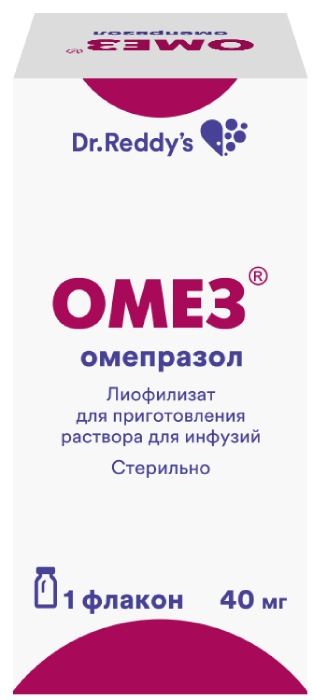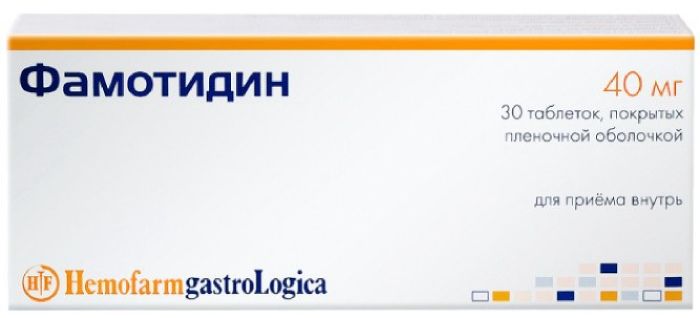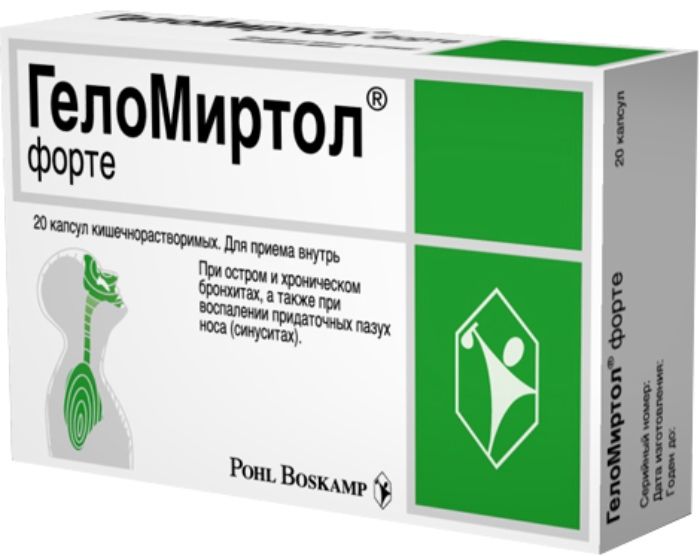- No products in the cart.
Omez lyophilisates for solution inf. 40mg vial 1 piece
$3.19
Omez lyophilisates for solution inf. 40mg vial 1 piece
Description
Composition
Active substance:
1 vial contains: 40 mg of omeprazole.
Excipients:
Sodium hydroxide 5.28 mg disodium edetate 1.00 mg.
Description:
A white or almost white lyophilisate in the form of a uniform porous cake or parts thereof, or in powder form.
Product form:
Lyophilizate for preparation of infusion solution, 40 mg. The drug vial of a colorless transparent glass type I (Eur Ph), chlorobutyl a sealed tube, crimped aluminum cap with plastic safety cover. Each vial together with instructions for use placed into cardboard pack.
Contraindications
Hypersensitivity to omeprazole or other components of the formulation.
Simultaneous treatment with erlotinib, posaconazole, nelfinavir and atazanavir.
During breastfeeding.
Children up to age 18 years (effectiveness and safety have not been established for this dosage form).
Carefully
Renal impairment (omeprazole dose correction is not needed).
Hepatic failure (see. The section “Method of administration and dosing regime”).
Osteoporosis. Although a causal relationship with the use of omeprazole fractures to osteoporosis has not been established, patients at risk of developing osteoporosis or fractures on his background should be kept under appropriate clinical supervision.
Pregnancy.
The simultaneous use of clopidogrel, itraconazole, warfarin, cilostazol, diazepam, phenytoin, saquinavir, tacrolimus, clarithromycin, voriconazole, rifampicin, Hypericum perforatum preparations.
Dosage
40 mg
Indications
As an alternative to oral therapy when the impossibility of its realization:
– gastric ulcer and duodenal ulcer (including relapse prevention);
– with gastroesophageal reflux disease (GERD);
– at hypersecretory states (Zollinger-Ellison syndrome, stress ulcers of the gastrointestinal tract, polyendocrine adenomatosis, systemic mastocytosis);
– for the prevention and treatment of lesions of the gastric mucosa and duodenal ulcer caused by nonsteroidal antiinflammatory drugs (NSAID gastropathy): dyspepsia, mucosal erosion, peptic ulcer; to prevent aspiration of acidic stomach contents into the airway during general anesthesia (Mendelson’s syndrome).
Interaction with other drugs
Reduction of gastric acid secretion in the stomach in the treatment of omeprazole and other proton pump inhibitors can cause a reduction or increase the absorption of other drugs, the absorption of which depends on the acidity of the medium.
Like other drugs, lowering gastric acidity, omeprazole treatment may result in decreased absorption of ketoconazole, itraconazole, posaconazole, erlotinib, iron and cyanocobalamin. Avoid co-administration of omeprazole.
The bioavailability of digoxin while the use of omeprazole is increased by 10% (may require correction mode digoxin). Caution must be exercised while the use of these drugs in elderly patients.
While the use of omeprazole may increase the plasma concentration and increase the half-life of warfarin, diazepam, phenytoin, cilostazol, imipramine, clomipramine, citalopram, hexobarbital, disulfiram, and other drugs metabolized in the liver with isoenzyme CYP2C19 (may require dose reduction of these drugs ).
It has been shown that omeprazole interact with some antiretroviral drugs. Mechanisms and clinical implications of these interactions are not always known. The increase in pH during treatment with omeprazole may interfere with the absorption of antiretroviral drugs. It is also possible for the interaction CYP2C19 isozyme level. If concomitant use of omeprazole and certain antiretroviral drugs such as atazanavir and nelfinavir, against the background of omeprazole therapy, there is a decrease in their serum concentrations. While the use of omeprazole is reduced by 75% area under the curve “concentration-time” atazanavir. In this connection, the combined use of omeprazole with antiretroviral drugs such as nelfinavir and atazanavir, is contraindicated.
With simultaneous use of omeprazole with clopidogrel antiplatelet a decrease of the latter effect.
If concomitant use of methotrexate with proton pump inhibitors in some patients, there was a slight increase in MTX concentration in blood plasma. In the treatment of high-dose methotrexate should temporarily stop taking omeprazole.
With simultaneous use of omeprazole and tacrolimus was observed increase of tacrolimus concentrations in blood serum, which may require correction of the dose.
The simultaneous use of inhibitors of isozymes CYP2C19 and CYP3A4 (such as clarithromycin, erythromycin, voriconazole) can lead to increased plasma concentration of omeprazole, a dose that may require adjustment of omeprazole in patients with severe liver failure patients in case of prolonged use.
Inductors isozymes CYP2C19 and CYP3A4, such as rifampicin, Hypericum perforatum preparations (Hypericum perforatum), when combined with omeprazole may lead to a decrease in the concentration of omeprazole in blood plasma by accelerating the metabolism of omeprazole.
When co-administered with omeprazole clarithromycin or erythromycin concentration of omeprazole in blood plasma increases.
Co-administration of omeprazole with amoxicillin or metronidazole does not affect the concentration of omeprazole in blood plasma.
Revealed no effect of omeprazole on antacids, theophylline, caffeine, quinidine, lidocaine, propranolol, ethanol.
Overdose
According to clinical studies with the intravenous administration of the drug to 270 mg per day and at a dose of 650 mg over three days, dose-related side effects were observed.
Symptoms: confusion, blurred vision, drowsiness, dry mouth, headache, nausea, tachycardia, arrhythmia.
Treatment: symptomatic. Hemodialysis is not effective enough.
pharmachologic effect
Pharmacological group:
Gastric glands secretion lowering agent – a proton pump inhibitor.
Pharmacodynamics:
A specific inhibitor of proton pump: inhibits the activity of H + / K + -ATPase in the parietal cells of the stomach, inhibiting the final stage of gastric acid secretion, thereby reduce acid production.
Reduces basal and stimulated secretion regardless of the nature of the stimulus.
Omeprazole is a prodrug and is activated in the acidic environment of the secretory tubules of parietal cells of the stomach.
Exposure is dose-dependent and provides effective and inhibition of basal and stimulated acid secretion irrespective of the nature stimulating factor.
Antisecretory effects after taking 20 mg occurs within the first hours, maximum – after 2 h 50% inhibition of maximal secretion lasts 24 hours. The.
A single dose per day provides a fast and effective inhibition of daytime and nocturnal gastric secretion, reaches its maximum after 4 days of treatment and disappear by the end of 3-4 days after admission. In patients with ulcer duodenum 12 receiving 20mg of omeprazole maintains the intragastric pH at 3 for 17 hours.
During the use of drugs that reduce the secretion of the glands of the stomach, gastrin concentration in blood plasma increases.
Due to the reduced secretion of hydrochloric acid concentration is increased chromogranin A (see. The section “Special instructions”).
Pharmacokinetics:
Communication with plasma proteins – 90-95% (albumin and alpha 1-acid glycoprotein).
The half-life (T1 / 2) for the final phase of the concentration-time curve “concentration-time” in the blood plasma after intravenous administration of omeprazole is about 40 minutes (with liver failure-3 hours); total plasma clearance is from 0.3 to 0.6 l / min. half-life value changes during treatment does not occur.
Almost completely metabolized in the liver with the enzyme cytochrome P450 (CYP) to form six pharmacologically inactive metabolites: gidroksiomeprazol, sulfide and sulfone derivatives, and others.
Much of omeprazole metabolism depends polymorphically-expressed specific isoform CYP2C19 (S-mephenytoin hydroxylase), responsible for the formation gidroksiomeprazol – main plasma metabolite. It is an inhibitor of the isozyme CYP2C19.
Excretion by the kidneys (70-80%) and the bile (20-30%). In chronic renal insufficiency excretion is reduced proportional to the reduction in creatinine clearance. In elderly patients, elimination decreases, bioavailability increases.
Pregnancy and breast-feeding
Use of the drug during pregnancy is possible only if the expected benefit to the mother outweighs the potential risk to the fetus.
During lactation should stop breastfeeding.
Conditions of supply of pharmacies
On prescription.
side effects
Incidence of adverse drug reactions is described according to the following gradation: very often (> 1/10); common (> 1/100,
special instructions
If you suspect a gastric ulcer during the early stages you must go through the X-ray or endoscopy to set the correct diagnosis and appropriate treatment.
If any alarming symptoms such as spontaneous significant weight loss, frequent vomiting, dysphagia, vomiting blood or melena, and also in the presence of gastric ulcers (or suspected stomach ulcer) should eliminate the possibility of cancer, since treatment with Omez® It can lead to a smoothing of symptoms and delay diagnosis.
Patients at risk of developing osteoporosis or fractures on his background should be kept under appropriate clinical monitoring, although a causal relationship omeprazole / esomeprazole with fractures to osteoporosis has not been established.
Due to the reduced secretion of hydrochloric acid concentration is increased chromogranin A (CgA). Increasing CgA plasma concentration can affect the results of the tests to detect neuroendocrine tumors. To prevent this effect therapy with proton pump inhibitors like to pause for 5 days before the study CgA concentration. If during this time the concentration of CgA has not returned to normal, the study should be repeated.
Effects on ability to drive and perform other activities that require concentration and speed of psychomotor reactions
During treatment with omeprazole may occur dizziness, drowsiness, blurred vision, so be careful when driving and performing other potentially hazardous activities that require high concentration and psychomotor speed reactions.
Storage conditions
In a dry, dark place at a temperature not higher than 25 C.
Keep out of the reach of children!.
Dosing and Administration
Omez® The drug is administered intravenously for 20-30 minutes. Recommended for infusion solution was administered immediately after its preparation. Doses are selected individually and sometimes requires the introduction of a higher dose. If the value exceeds the daily dose of 60 mg, the dose should be divided into two steps.
As an alternative to oral therapy when the impossibility of its realization: -at gastric ulcer and duodenal ulcer (including relapse prevention) is recommended to appoint infusion Omez® drug at a dose of 40 mg once daily; -with gastroesophageal reflux disease (GERD) is recommended to assign Omez® drug infusion at a dose of 40 mg once a day; -with hypersecretory states (Zollinger-Ellison syndrome, stress ulcers of the gastrointestinal tract, polyendocrine adenomatosis, systemic mastocytosis), recommended initial intravenous Omez® drug in a dose of 60 mg per day; -for the prevention and treatment of lesions of the gastric mucosa and duodenal ulcer caused by nonsteroidal anti-inflammatory drugs – NSAID-gastropathy (dyspepsia, mucosal erosion, peptic ulcer) is recommended to assign Omez® drug infusion at a dose of 40 mg once a day.
To prevent aspiration of acidic gastric contents into the airway during general anesthesia (Mendelson’s syndrome) the day before the drug is prescribed for the night in a dose of 40 mg and not less than 2 hours prior to anesthesia / surgery 40mg. After closure of parenteral therapy to suppress acid secretion holding antisecretory therapy recommended oral dosage forms (e.g., omeprazole 40 mg once a day for 4 weeks).
Use of the drug in specific cases
Impaired renal function. No dose adjustment is required.
Abnormal liver function. In patients with impaired liver function bioavailability and clearance of omeprazole are increased. In this connection, the therapeutic dose should not exceed 20 mg per day.
Elderly age. the rate of metabolism of omeprazole in elderly patients is reduced, but dose adjustment is not required.
Instructions for preparing the solution for infusion
Infusion solution is prepared by dissolving a lyophilized powder omeprazole in 100 ml of 5% dextrose (glucose) infusion or infusion in 100 ml saline.
Solution for infusion of 5% dextrose (glucose) should be used within 6 hours. The infusion solution at a physiological solution should be used within 12 hours. Before administration should ensure no suspended particles in the solution.
Preparation of the solution for infusion in vials
1. Dial syringe 5 ml solution for infusion from the vial.
2. Enter an infusion solution into the vial with lyophilized powder omeprazole Shake until complete dissolution of the drug.
3. Dial the syringe omeprazole solution.
4. Transfer the solution into a vial omeprazole.
5. Repeat steps 1-4 to transfer all of the drug from the vial.
Solution for infusion in a soft container
1. To prepare the solution used for infusion sided needle (-perehodnik). One end of the needle to pierce the membrane of the infusion bag, the other end of the needle to connect with the vial of lyophilized omeprazole.
2. Dissolve powder omeprazole, pumping the infusion solution from the bag and back into the vial.
3. Ensure that the powder is completely dissolved, then disconnect and remove the empty bottle needle of the infusion bag.
Information
Appearance may differ from that depicted in the picture. There are contraindications. You need to read the manual or consult with a specialist
Additional information
| Weight | 0.100 kg |
|---|---|
| Manufacturer | DR.REDDIS |













There are no reviews yet.